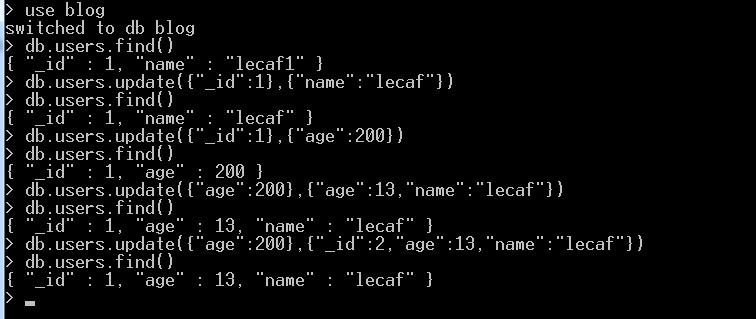show dbs; 显示db名称及占用情况
show collections; 显示db下面的collection的名称
use xxdb; 使用具体的db
db.dropDatabase(); 删除指定数据库,必须现use xxdb再使用
db.xxcollection.drop(); 删除集合
db.xxcollection.find(); 查看collection中的记录
db.xxcollection.remove({_id:xxx}); 删除记录
mongoexport --port 10240 -d xxdb -c xxcollection -o xxcollection.dat; 导出数据, 数据格式为json
mongoexport --port 10240 -d xxdb -c xxcollection -csv -f uid,username,age -o xxcollection.dat; 导出数据,数据格式为csv(逗号分割值)
mongoimport --port 10240 -d xxdb -c xxcollection -o xxcollection.dat ; 导入数据,数据格式为json
mongoimport --port 10240 -d xxdb -c xxcollection --type csv --headerline -file user_csv.dat ; 导入数据,数据格式为csv,不导入第一行(该行为列名)
mongodump -d xxdb -o xxdbdir; 数据库备份到xxdbdir目录下
mongorestore -d xxdb xxdbdir/*; 恢复数据到指定库下
测试失败,许重新测试
mongod -f file.cnf --auth --fork; mongod启动时指定认证
mongo --port xxx -u username -p; 指定用户名密码登录
查询所有
db.xxcollection.find()
查询一条记录
db.xxcollcetion.findOne();
查询指定条数记录
db.xxcollection.find({xxx:xxx}).limit(n);
排序
db.xxcollection.find({xxxx:xxxx}).sort('date',1);
分页
db.xxcollection.find({memberid:test}).skip(20n).limit(20).sort('date',1);
1.常用的命令
- show dbs 显示数据库列表
- use dbname 进入dbname数据库,大小写敏感,没有这个数据库也不要紧
- show collections 显示数据库中的集合,相当于表格
2.创建&新增
- db.users.save({"name":"lecaf"}) 创建了名为users的集合,并新增了一条{"name":"lecaf"}的数据
- db.users.insert({"name":"ghost", "age":10}) 在users集合中插入一条新数据,,如果没有users这个集合,mongodb会自动创建
- save()和insert()也存在着些许区别:若新增的数据主键已经存在,insert()会不做操作并提示错误,而save() 则更改原来的内容为新内容。
- 存在数据:{ _id : 1, " name " : " n1 "} ,_id是主键
- insert({ _id : 1, " name " : " n2 " }) 会提示错误
- save({ _id : 1, " name " : " n2 " }) 会把 n1 改为 n2 ,有update的作用。
3.删除
- db.users.remove() 删除users集合下所有数据
- db.users.remove({"name": "lecaf"}) 删除users集合下name=lecaf的数据
- db.users.drop()或db.runCommand({"drop","users"}) 删除集合users
- db.runCommand({"dropDatabase": 1}) 删除当前数据库
4.查找
- db.users.find() 查找users集合中所有数据
- db.users.findOne() 查找users集合中的第一条数据
5.修改
- db.users.update({"name":"lecaf"}, {"age":10}) 修改name=lecaf的数据为age=10,第一个参数是查找条件,第二个参数是修改内容,除了主键,其他内容会被第二个参数的内容替换,主键不能修改,如图

三、高级应用
1.条件查找
- db.collection.find({ "key" : value }) 查找key=value的数据
- db.collection.find({ "key" : { $gt: value } }) key > value
- db.collection.find({ "key" : { $lt: value } }) key < value
- db.collection.find({ "key" : { $gte: value } }) key >= value
- db.collection.find({ "key" : { $lte: value } }) key <= value
- db.collection.find({ "key" : { $gt: value1 , $lt: value2 } }) value1 < key <value2
- db.collection.find({ "key" : { $ne: value } }) key <> value
- db.collection.find({ "key" : { $mod : [ 10 , 1 ] } }) 取模运算,条件相当于key % 10 == 1 即key除以10余数为1的
- db.collection.find({ "key" : { $nin: [ 1, 2, 3 ] } }) 不属于,条件相当于key的值不属于[ 1, 2, 3 ]中任何一个
- db.collection.find({ "key" : { $in: [ 1, 2, 3 ] } }) 属于,条件相当于key等于[ 1, 2, 3 ]中任何一个
- db.collection.find({ "key" : { $size: 1 } }) $size 数量、尺寸,条件相当于key的值的数量是1(key必须是数组,一个值的情况不能算是数量为1的数组)
- db.collection.find({ "key" : { $exists : true|false } }) $exists 字段存在,true返回存在字段key的数据,false返回不存在字度key的数据
- db.collection.find({ "key": /^val.*val$/i }) 正则,类似like;“i”忽略大小写,“m”支持多行
- db.collection.find({ $or : [{a : 1}, {b : 2} ] }) $or或 (注意:MongoDB 1.5.3后版本可用),符合条件a=1的或者符合条件b=2的数据都会查询出来
- db.collection.find({ "key": value , $or : [{ a : 1 } , { b : 2 }] }) 符合条件key=value ,同时符合其他两个条件中任意一个的数据
- db.collection.find({ "key.subkey" :value }) 内嵌对象中的值匹配,注意:"key.subkey"必须加引号
- db.collection.find({ "key": { $not : /^val.*val$/i } }) 这是一个与其他查询条件组合使用的操作符,不会单独使用。上述查询条件得到的结果集加上$not之后就能获得相反的集合。
2.排序
- db.collection.find().sort({ "key1" : -1 ,"key2" : 1 }) 这里的1代表升序,-1代表降序
3.其他
- db.collection.find().limit(5) 控制返回结果数量,如果参数是0,则当作没有约束,limit()将不起作用
- db.collection.find().skip(5) 控制返回结果跳过多少数量,如果参数是0,则当作没有约束,skip()将不起作用,或者说跳过了0条
- db.collection.find().skip(5).limit(5) 可用来做分页,跳过5条数据再取5条数据
- db.collection.find().count(true) count()返回结果集的条数
- db.collection.find().skip(5).limit(5).count(true) 在加入skip()和limit()这两个操作时,要获得实际返回的结果数,需要一个参数true,否则返回的是符合查询条件的结果总数



